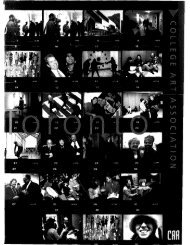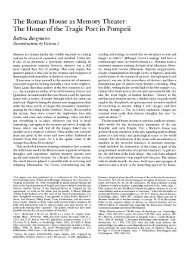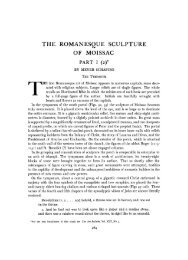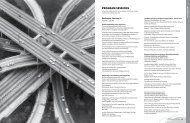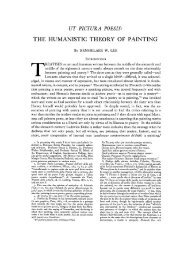Forms of Respect: Alois Riegl's Concept of Attentiveness
Forms of Respect: Alois Riegl's Concept of Attentiveness
Forms of Respect: Alois Riegl's Concept of Attentiveness
You also want an ePaper? Increase the reach of your titles
YUMPU automatically turns print PDFs into web optimized ePapers that Google loves.
292 THE ART BULLETIN JUNE 1989 VOLUME LXXI NUMBER 2<br />
4 Gerard Ter Borch, "Paternal Admonition, " ca. 1654.<br />
Amsterdam, Rijksmuseum-Stichting<br />
in pathos.54 Attention is active but "allows external objects<br />
to affect it, and does not seek to overcome them."55 The<br />
ethical thrust he gave to different varieties <strong>of</strong> union is <strong>of</strong>ten<br />
explicit. Faust's presumption, for example, was a desire for<br />
the "connection <strong>of</strong> his own mind with the whole world."56<br />
This aggressive form <strong>of</strong> union contrasts to a more humble<br />
form: "Prayer is union with God."''7 Rembrandt, Riegl<br />
wrote, "strives for deep psychological union between the<br />
people he paints and the beholder, for serious emotions<br />
such as goodness, devotion, ... (all, that is, means <strong>of</strong><br />
expression <strong>of</strong> connection), thus, for the highest ethical feel-<br />
ings <strong>of</strong> which man is at all capable."58 Clearly, Riegl thought<br />
attentiveness, and all it entailed, not only an effective way<br />
to unify a picture, but an admirable way to lead one's life,<br />
in concord with one's fellow man. It meant respect (or re-<br />
gard), democracy, equality. A present-day psychiatrist<br />
would approve it as a mark <strong>of</strong> good "object-relations."<br />
There is even a religious element in <strong>Riegl's</strong> interpretation<br />
<strong>of</strong> attention. Its origin was the respect for the external world<br />
legislated by Early Christian ethics. Riegl called this "ob-<br />
54 For "selbstlose Aufmerksamkeit" see Riegl, 1902/1931, 262, 274. The<br />
"will" to which Riegl refers is the urge to power, rather than volition in<br />
general, and Riegl differentiates the two by using the noun form, Wille,<br />
for the urge to power, and the verb form, Wollen, for volition, which<br />
saves him the possible contradiction <strong>of</strong> arguing that a Kunstwille can be<br />
directed against Wille. For an example <strong>of</strong> <strong>Riegl's</strong> use <strong>of</strong> the terms "Wille"<br />
and "Gefifihl," see Riegl, 1902/1931, 13-14. An early sketch for Das holliindische<br />
Gruppenportriit includes a chart that maps the opposition between<br />
will and feeling. At this stage, Riegl still sought to include attention<br />
in this polarity, crossing it out from under the heading "Wille zur Verbindung,"<br />
and finally placing it under "verbindende Empfindung"; Riegl,<br />
Ms, carton 7, folder b, p. 9.<br />
ss Riegl, 1902/1931, 14.<br />
56 "Es ist Verbindung der eigenen Geiste mit der ganzen Welt"; Riegl, Ms,<br />
jective" phase "attention in the Christian sense."59 Later,<br />
increasing specificity in time and space allowed the depic-<br />
tion <strong>of</strong> attention as the free choice <strong>of</strong> the individual. The<br />
perfect balance <strong>of</strong> subject and object reached in the Syndics<br />
depends on a mixture <strong>of</strong> self-interest with the fully inter-<br />
nalized imperative to deal honestly with the public.60 Since<br />
a feeling that is too egoistic can submerge attention, he<br />
argued that feeling is infused into the portrait "not in the<br />
form <strong>of</strong> self-awareness . . . but as sympathy, which rejects<br />
all subordination and simply motivates attention in an out-<br />
ward direction."61 The term "sympathy" evokes the ethical<br />
implications that Wundt, too, ascribed to attention.<br />
Even in the demise <strong>of</strong> attentiveness, an ethical element<br />
was present. Its last, "novelistic," phase had almost sinister<br />
overtones. External coherence was created by so engrossing<br />
the beholder in an analysis <strong>of</strong> the psychological ties be-<br />
tween the characters that the scene becomes his own inner<br />
experience.62 The distrust with which Riegl viewed this<br />
phase is suggested in his description <strong>of</strong> the style <strong>of</strong> genre<br />
painting from which he thought it emerged. In such paint-<br />
ings as the Terborch that Riegl knew as Paternal Admo-<br />
nition, selfless attention becomes "an assumed mask" under<br />
which lie "secret passions which the master knew how to<br />
disguise in the most clever fashion" (Fig. 4).<br />
It follows that Terborch's art has distanced itself further<br />
from the original ideal <strong>of</strong> Dutch art - selfless attention<br />
- than did any earlier phase. Terborch is the painter <strong>of</strong><br />
that clever egoism which does not seek to explain its<br />
knowledge <strong>of</strong> the weakness <strong>of</strong> others by attributing it to<br />
common humanity, but uses it to triumph over others<br />
tyrannically.63<br />
<strong>Riegl's</strong> ethical interpretation <strong>of</strong> attention culminates in a<br />
defense <strong>of</strong> the theatricality <strong>of</strong> Baroque art. According to<br />
its critics, the figures in the paintings pretend to address<br />
one another, but, like players, they in fact turn to address<br />
the audience. Riegl accepted the characterization, but de-<br />
fended the art. Theatricality, he argued, did not represent<br />
a "conscious lie."<br />
They are accused <strong>of</strong> acting, in their pictures, as though<br />
they knew nothing <strong>of</strong> a beholder, and yet arranging<br />
everything for the beholder. In fact, they demonstrated<br />
carton 6, folder 3, p. 64. The passage is from a practicum on Rembrandt,<br />
<strong>of</strong>fered in 1900-01.<br />
57 "Gebet ist Verbindung mit Gott"; ibid., 65.<br />
58 "Er strebt nach tiefere seelische Verbindung zwischen den von ihm gem-<br />
alten Menschen und dem Beschauer, nach ernsteren Affekten wie Gute,<br />
Hingebung, . . . (also alles Ausdruckweisen der Verbindung), also nach<br />
den h6chsten ethischen Geffihlen, deren der Mensch tiberhaupt fihig ist";<br />
Riegl, Ms, carton 6, folder 2, p. 86 (1900-01).<br />
59 Riegl, 1902/1931, 23, 44.<br />
60 Ibid., 210.<br />
61 Ibid., 88.<br />
62 Ibid., 260.<br />
63 Ibid., 273-274.



